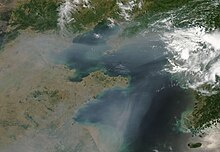Pollution in China
[citation needed] The presence of heavy metals (including mercury, lead, cadmium, copper, nickel, chromium, and zinc) in the contaminated soil have adverse health effects on human metabolism.
[4] As China's waste production increases, insufficient efforts to develop capable recycling systems have been attributed to a lack of environmental awareness.
[10] Pesticides and fertilizer residues, packaging associated, bags and mulch film are largely left untreated in landfills, often due to a lack of waste management infrastructure.
It refers to the color of white plastic shopping bags, Styrofoam containers, and other light-colored materials that began turning up in visible volume in agricultural fields, the landscape, and waterways in the mid-to-late 1990s.
The article's main points included:[20] A draft of a 2007 combined World Bank and SEPA report stated that up to 760,000 people die prematurely each year in China due to air and water pollution.
The review stated that "although China is starting from a point of grave pollution, it is setting priorities and making progress that resemble what occurred in industrialized countries during their earlier stages of development."
[24] Conventional approaches to air quality monitoring in China are based on networks of static and sparse measurement stations.
A study from 2012 showed fine particles in the air, which cause respiratory and cardiovascular diseases were one of the key pollutants that accounted for a large fraction of damage on the health of Chinese citizens.
[27] In response, China has taken measures such as rapidly building out the water infrastructure and increased regulation as well as exploring a number of further technological solutions.
[citation needed] In northern China, air pollution from the burning of fossil fuels, principally coal, is causing people to die on average 5.5 years sooner than they otherwise might.
In 2016, only 84 out of 338 prefecture-level (administrative division of the People's Republic of China (PRC), ranking below a province and above a county) or higher cities attained the national standard for air quality.
[46] Measurements by Beijing municipal government in January 2013 showed that highest recorded level of PM2.5 (particulate matter smaller than 2.5 micrometers in size), was at nearly 1,000 μg per cubic meter.
[61][62][63] In June 2012, following strongly divergent disclosures of particulate levels between the Observatory and the US Embassy, Chinese authorities asked foreign consulates to stop publishing "inaccurate and unlawful" data.
[74] The main goal of the plan is to reduce coal consumption by closing polluting mills, factories, and smelters and switching to other eco-friendly energy sources.
[76] On 20 August 2015, ahead of the 70th-anniversary celebrations of the end of World War II, the Beijing government shut down industrial facilities and reduced car emissions in order to achieve a "Parade Blue" sky for the occasion.
This action resulted in PM2.5 concentration lower than the 35 μg/m3 national air quality standard,[77] according to data from Beijing Municipal Environmental Protection Monitoring Centre (BMEMC).
Substituting the share of coal-fired power plants with renewable and nuclear energy also requires 700GW of additional capacity, which costs 184 billion dollars.
[79]In northern China, air pollution from the burning of fossil fuels, principal [sic] coal, is causing people to die on average 5.5 years sooner than they otherwise might.Beijing launched the four-color alert system in 2013.
In 2011, there were riots in the Zhejiang Haijiu Battery Factory from angry parents whose children received permanent neurological damage from lead poisoning.
The central government has acknowledged the problem and has taken measures, such as suspending battery factory production, but some see the response as inadequate and some local authorities have tried to silence criticisms.
A plan of action for 2010 includes objectives such as eliminating the production, import and use of the pesticides covered under the convention, as well as an accounting system for PCB containing equipment.
[87] China faces challenges in controlling and eliminating POPs, since they often are cheaper than their alternatives or are unintentionally produced and then released into the environment to save on treatment costs.
[88] Sulfur (an acid rain component), soot, ash, carbon monoxide, and other toxic pollutants including heavy metals (such as mercury, cadmium, chromium, arsenic, lead, zinc, copper) and other carcinogens, often accompany the dust storms, as well as viruses, bacteria, fungi, pesticides, antibiotics, asbestos, herbicides, plastic ingredients, combustion products and hormone mimicking phthalates.
The Proceedings of the National Academy of Sciences also highlights the Huai River Policy established during China's central planning period between 1950 and 1980.
[94] A 2007 World Bank and SEPA report estimated the cost of water and air pollution in 2003 to be 2.68% or 5.78% of GDP depending on the use of either a Chinese or a Western method of calculation.
[96] A 2013 study published in the Proceedings of the National Academy of Sciences found that severe pollution during the 1990s cut five and a half (5.5) years from the average life expectancy of people living in northern China, where toxic air has led to increased rates of stroke, heart disease and cancer.
[97] A 2015 study from the non-profit organization Berkeley Earth estimated that 1.6 million people in China die each year from heart, lung and stroke problems because of polluted air.
[98] Ironically, a 2024 study found that precipitous declines in pollution, following the 2013 clean air action plan, may have contributed to the anomalous Blob, an immense and intense patch of warming in the Pacific Ocean.
[100] As of 2019: According to the National Environmental Analysis released by Tsinghua University and The Asian Development Bank in January 2013, seven of the ten most air polluted cities in the world are in China, including Taiyuan, Beijing, Urumqi, Lanzhou, Chongqing, Jinan and Shijiazhuang.
[102] The Operation National Sword (ONS) was a policy initiative launched in 2017 by the government of China to monitor and more stringently review recyclable waste imports.




